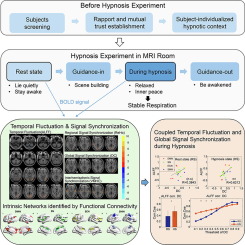当前位置:
X-MOL 学术
›
Neuroscience
›
论文详情
Our official English website, www.x-mol.net, welcomes your feedback! (Note: you will need to create a separate account there.)
Coupled Temporal Fluctuation and Global Signal Synchronization of Spontaneous Brain Activity in Hypnosis for Respiration Control: An fMRI Study.
Neuroscience ( IF 3.3 ) Pub Date : 2020-01-07 , DOI: 10.1016/j.neuroscience.2019.12.032 Yanjun Liu 1 , Yini He 2 , Rongmao Li 3 , Shaode Yu 4 , Jianyang Xu 5 , Yaoqin Xie 1
Neuroscience ( IF 3.3 ) Pub Date : 2020-01-07 , DOI: 10.1016/j.neuroscience.2019.12.032 Yanjun Liu 1 , Yini He 2 , Rongmao Li 3 , Shaode Yu 4 , Jianyang Xu 5 , Yaoqin Xie 1
Affiliation

|
Hypnosis is a psychological technology proved to be effective in respiratory motion control, which is essential to reduce radiation dose during radiotherapy. This study explored the neural mechanisms and cognitive neuroscience of hypnosis for respiration control by functional magnetic resonance imaging with a within-subject design of 15 healthy volunteers in rest state (RS) and hypnosis state (HS). Temporal fluctuation and signal synchronization of brain activity were employed to investigate the altered physiological performance in hypnosis. The altered correlations between temporal fluctuation and signal synchronization were examined within large scale of intrinsic networks which were identified by seed-wise functional connectivity. As a result, hypnosis was observed with increased activity in the right calcarine, bilateral fusiform gyrus and left middle temporal gyrus, and with decreased activity in the left cerebellum posterior lobe (inferior semilunar lobule part). Compared to RS, enhanced positive correlations were observed between temporal fluctuation and signal synchronization in HS. Most importantly, coupled correlation was observed between temporal fluctuation and global signal synchronization within the identified intrinsic networks (R = 0.3843, p > 0.05 in RS; R = 0.6212, p < 0.005 in HS). The findings provide implications for the neural basis of hypnosis for respiratory motion control and suggest the involvement of emotional processing and regulation of perceptual consciousness in hypnosis.
中文翻译:

功能性磁共振成像研究:催眠中自发性大脑活动的时间波动和整体信号同步耦合。
催眠是一种被证明对呼吸运动控制有效的心理技术,对减少放射治疗期间的辐射剂量至关重要。这项研究探索了催眠的神经机制和认知神经科学,通过功能性磁共振成像对15名健康志愿者的静止状态(RS)和催眠状态(HS)进行受试者内设计,以控制呼吸。大脑活动的时间波动和信号同步被用来研究催眠中生理功能的改变。在大范围的内在网络中检查了时间波动和信号同步之间的变化相关性,这些内在网络由种子方式的功能连通性确定。结果,观察到催眠在右侧钙car碱中具有增强的活性,双侧梭状回和左中颞回,左小脑后叶(下半月小叶部分)活动减少。与RS相比,HS中的时间波动和信号同步之间增强了正相关。最重要的是,在确定的内在网络中观察到时间波动与全局信号同步之间的耦合相关性(RS中R = 0.3843,p> 0.05; HS中R = 0.6212,p <0.005)。这些发现为催眠的神经基础提供了呼吸运动控制的暗示,并暗示了催眠过程涉及情绪处理和知觉调节。在HS中,在时间波动和信号同步之间观察到增强的正相关。最重要的是,在已识别的内在网络中观察到时间波动与全局信号同步之间的耦合相关性(RS中R = 0.3843,p> 0.05; HS中R = 0.6212,p <0.005)。这些发现为催眠的神经基础提供了呼吸运动控制的依据,并暗示了催眠过程中涉及情绪处理和知觉调节。在HS中,在时间波动和信号同步之间观察到增强的正相关。最重要的是,在已识别的内在网络中观察到时间波动与全局信号同步之间的耦合相关性(RS中R = 0.3843,p> 0.05; HS中R = 0.6212,p <0.005)。这些发现为催眠的神经基础提供了呼吸运动控制的依据,并暗示了催眠过程中涉及情绪处理和知觉调节。
更新日期:2020-01-07
中文翻译:

功能性磁共振成像研究:催眠中自发性大脑活动的时间波动和整体信号同步耦合。
催眠是一种被证明对呼吸运动控制有效的心理技术,对减少放射治疗期间的辐射剂量至关重要。这项研究探索了催眠的神经机制和认知神经科学,通过功能性磁共振成像对15名健康志愿者的静止状态(RS)和催眠状态(HS)进行受试者内设计,以控制呼吸。大脑活动的时间波动和信号同步被用来研究催眠中生理功能的改变。在大范围的内在网络中检查了时间波动和信号同步之间的变化相关性,这些内在网络由种子方式的功能连通性确定。结果,观察到催眠在右侧钙car碱中具有增强的活性,双侧梭状回和左中颞回,左小脑后叶(下半月小叶部分)活动减少。与RS相比,HS中的时间波动和信号同步之间增强了正相关。最重要的是,在确定的内在网络中观察到时间波动与全局信号同步之间的耦合相关性(RS中R = 0.3843,p> 0.05; HS中R = 0.6212,p <0.005)。这些发现为催眠的神经基础提供了呼吸运动控制的暗示,并暗示了催眠过程涉及情绪处理和知觉调节。在HS中,在时间波动和信号同步之间观察到增强的正相关。最重要的是,在已识别的内在网络中观察到时间波动与全局信号同步之间的耦合相关性(RS中R = 0.3843,p> 0.05; HS中R = 0.6212,p <0.005)。这些发现为催眠的神经基础提供了呼吸运动控制的依据,并暗示了催眠过程中涉及情绪处理和知觉调节。在HS中,在时间波动和信号同步之间观察到增强的正相关。最重要的是,在已识别的内在网络中观察到时间波动与全局信号同步之间的耦合相关性(RS中R = 0.3843,p> 0.05; HS中R = 0.6212,p <0.005)。这些发现为催眠的神经基础提供了呼吸运动控制的依据,并暗示了催眠过程中涉及情绪处理和知觉调节。



























 京公网安备 11010802027423号
京公网安备 11010802027423号